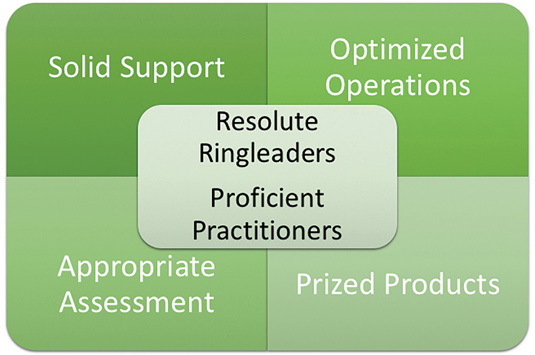 While healthy, mature content organizations are always the goal (I’ve never heard a team say, “We’re aiming to be chaotic and build a toxic culture!”), they always seem to be elusive—aspirational but never achievable.
While healthy, mature content organizations are always the goal (I’ve never heard a team say, “We’re aiming to be chaotic and build a toxic culture!”), they always seem to be elusive—aspirational but never achievable.
When I envisioned this issue’s theme, The Healthy Content Organization, I wanted to bring together some data, some thought leadership, and some experienced practitioners who all had interesting, enlightening, and most importantly, actionable things to share about how content organizations can excel.
My goal? To get you closer to your goal of a healthy organization.
Before you dive into the issue, Figure 1 shows what I believe to be the key hallmarks of a healthy content organization.

The Content Team
Many technical communicators believe that having a group of skilled writers and editors and a manager who is supportive and fun is all you need. They are baffled when the team is not productive, is not creating valuable content, or is constantly frustrated. While resolute ringleaders and proficient practitioners, as shown in the center of Figure 1, are critical, the ecosystem around the team can quickly kill—or just torture slowly—the soul of a potentially great content organization.
The environment around a great content team, however, will likely never be effective without that healthy core.
Resolute Ringleaders
Without strong leadership, the team flounders. This is the brain—the command center—of the team. A leader treats the content organization like a mini business within the larger product team or company. The other functions on the product team—engineering or R&D, product management, marketing, sales, design, release management, support, etc.—are partners to a great content leader, all working together in service of a common client: the company’s customer.
This leader need not be a content manager, although it’s nice if you have a team that’s large and specialized enough to have one. A small team reporting to an engineering or marketing manager can still have strong content leadership—maybe it’s you! A leader needs vision, goals, and the ability to rally others around that vision to achieve those goals. A leader must influence in all directions—up, down, and to the sides in the corporate hierarchy. There’s a lot to unpack in those sentences, but I’m not going to do it here because next month’s theme is … wait for it … leadership! We’ll be exploring that theme in a lot of detail, so don’t miss the May/June issue!
Proficient Practitioners
Clearly, there is no team without the folks who envision, plan, architect, design, and develop the content. This is the heart of the team, and the strongest hearts are always moving and being exercised—and the best practitioners don’t sit still or rest on the laurels of “table stakes” skills in basic writing and editing.
Highly valued practitioners have a baseline level of skill in all dimensions of the content business—from architecture and project management to writing and editing—and they specialize in at least one. As their teams get bigger (and hopefully—although not always—more mature), they specialize more, going deeper in their skillset, as well as broadening their knowledge to related skills, such as design and usability, product management, and marketing.
The key is to remain teachable. As technical communicators, this is our super power, so use it in every facet of your life: thrive on learning about your next new product, as well as staying current and building depth and breadth in the latest tech comm trends, tools, and methods.
The Content Ecosystem
If leaders and practitioners are the brain and heart of the tech comm team organism, the ecosystem around us is the environment that enables us to maintain life. As Figure 1 shows, we are literally surrounded by the people, products, and processes that we work with (or possibly around) every day. If that environment is less like Earth and more like Mars, it can mean the death of the content organization. Even if we have good protection, like a space suit (in the form of our leader) we will cease to thrive.
An ecosystem that enables content teams to thrive also thrives on content. What does a symbiotic organization look like? It serves customers with prized products, provides solid support, accomplishes goals through optimized operations, and appropriately assesses itself and all of the organisms within it to continually improve in products, support, and operations.
Prized Products
An organization that well understands and appreciates its audience and customers and what they need has the foundation to deliver valuable products. Add to that understanding a talented, cross-functional team of partners, and you end up with products that appreciative customers prize over others. Appreciative audiences and prized products generate pleasing profits.
Solid Support
Understanding of the business value of content and supporting the teams that create that content is not typically something that comes naturally to organizations. This is where your strong leader must play an influential role, evangelizing your team’s vision and goals, as well as building partnering relationships with other product-team leaders.
Optimized Operations
One-offs are costly; habits and systems are efficient and make us more effective. We are the kings and queens of procedure. Therefore, we should be the most highly systematized and optimized organizations in our enterprises. If you aren’t yet, get on that. Consider what you or your team is doing that doesn’t make sense for you. Ask yourself what you could automate to free up precious time for content development or other high-value activities. Is everyone on your team operating at their highest level—could your most senior folks be delegating to those who are becoming more senior? This is how you not only get the most valuable results from every team member, but you also build important skills and capability on your team.
Appropriate Assessment
What doesn’t get measured, incented, or rewarded doesn’t get done. You and your team should be measuring the effectiveness of everything—yourselves, your results, your processes, your content—and the ecosystem around you should also be measured constantly. This is the data that will help you to refine your leadership, your practitioners’ skills, your products, your relationships with the people who drive the business you work in, and the systems and practices that enable you to deliver great content to your appreciative audiences every day.
A Note About Role
Notice that specific roles are not one of my hallmarks. Future-focused flexibility (I had to get in one more alliteration) is best supported by an activity- and skill-based approach. As the industry, business, and our customers change, we can quickly pivot in discussions of our value and impact if we converse in these terms. It’s difficult to have these conversations as an industry, because every company has its own organization structure, roles, titles, etc., but activities and skills apply equally to all.
In This Issue
As you read further, think about these hallmarks of a healthy team. Where does your team stand? Are you robust and healthy, able to leap tall help systems in a single editing pass? Or are you a little sickly around the edges, not eating enough veggies or getting enough exercise? You will have lots of opportunities to consider these ideas and take action based on the articles in this issue.
Dawn Stevens, President of Comtech Services and Director of the Center for Information-Development Management (CIDM), starts us off with a look at where we are today as an industry in content organization maturity. CIDM has been collecting data for years from content organizations of all sizes, and the 2017 data is interesting. Thank you, Dawn, for breaking it down for us, and exposing the insights in the numbers.
Then Michele Linn, former Vice President of Editorial at the Content Marketing Institute (CMI), and I collaborate on the ultimate guide to your content marketing team! A healthy technical content organization doesn’t stop at the boundaries of the technical communication team—you’ve got to get out of your cube and start making frenemies … I mean friends … with your misunderstood colleagues on the other side of “the buy gap.” Thanks, Michele, for the secret treasure map to the content marketing organization. Note that the volume of marketing goodness in this article means that we had abridge it and publish the full version online. See www.stc.org/intercom for the full article.
Next, Michael Priestley, Senior Technical Staff Member and Enterprise Content Technology Strategist at IBM, dives into incentives. As we know, we get what we measure and reward! Thank you, Michael, for uncovering some of the common pitfalls of measurement and reward on content teams.
While this issue has some enterprise content team focus, healthy relationships are not the sole purview of corporate staff. Saul Carliner, Professor of Educational Technology at Concordia University, gives freelancers, contractors, and consultants eight strategies for creating healthy relationships with clients. If you are corporate staff, not to worry, as these tips apply to you as well! Thanks, Saul, for tips we can all use to better our relationships.
In our last feature, which you can read on www.stc.org/intercom, Myra Cook Brown, freelancer, Academic Advisor, and Technical Writer/Editor for Utah State University, explores a specific freelancer-client relationship around style and style guidance. Remember, a healthy content organization has optimized operations—and that includes ensuring that consistency, branding, etc., are optimized into our processes. Thank you, Myra, for providing concrete actions that freelancers can take today to better the health of their client relationships. Due to the excitement about this month’s theme, we had more content than we could print, so don’t miss Myra’s article on the Intercom website!
We have two new columns this month as well. I’m thrilled to introduce to you Editing Matters and Convergence Conversations. In Editing Matters, Michelle Corbin, a Senior Technical Editor and Information Architect at IBM, tells us in her inaugural column why editing matters matter in a healthy content organization. Alan Porter, Head of Strategic Services at [A], addresses the technical communication convergence—not just a healthy relationship with—marketing in the first of his Convergence Conversations. Thank you, Alan and Michelle, for agreeing to bring Intercom readers some fresh insights in these areas throughout the year.
If you are wondering what your fellow technical communicators do in their spare time, J. J. Haas, author of Welcome to Sugarville: A Novel in Stories, talks about technical writing versus creative writing in the most recent Off Hours.
And, in the Society Pages, we sadly mark the passing of past STC President, Fellow, active member, leader, mentor, and friend David Armbruster. George Hayhoe remembers David, and I will reinforce here that “David never met a stranger.” Thank you, George, for so eloquently capturing the spirit of what David meant to those who knew him and the impact he had on the Society and our industry. And thank you, David, for being our friend.
I would love to know what you think of the issue—criticism (constructive, please!) or praise. Comment below (on the website), reach out to me (at my email address below) or to the team (intercom@stc.org), or shout out to us on Twitter (@stc_org).
— Andrea L. Ames
andrea@idyllpointllc.com


